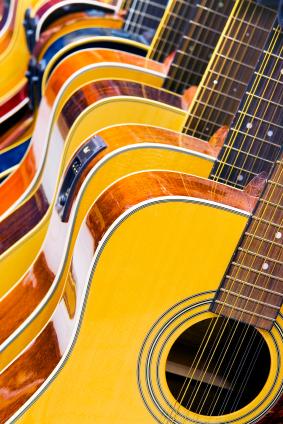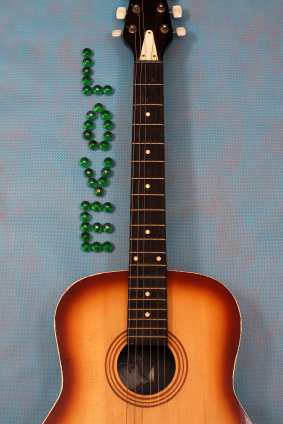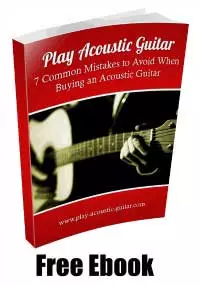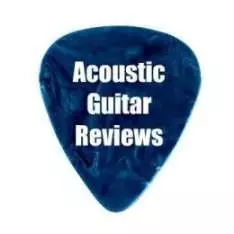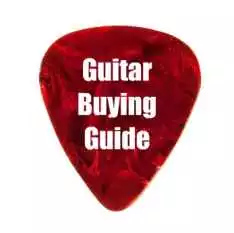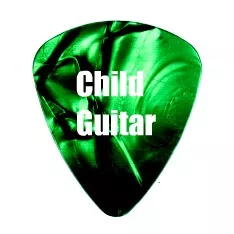|
How to Choose the Best Beginner Acoustic GuitarBuying Tips
Every beginner acoustic guitar student should practice with a good quality, affordable instrument. One's best first guitar is not necessarily the most expensive instrument. Also consider used acoustic guitars , where you can get quality instruments for half the price. Looking to purchase your first acoustic guitar? Surely you have already read a few acoustic guitar reviews from the best guitar makers? While reviews can be helpful, they can be overwhelming and lack an holistic, informed perspective. As an instructor, I always say that the first acoustic guitar should accent the player in form, fit and function. In other words, the beginner guitar needs to be comfortable, and easy to hold and easy to play. You will be practicing on that guitar for at least 1 hour a day, so it needs to fit with your body. When searching for the perfect instrument, note that the best beginner acoustic guitar will differ from player to player.
Guitar TopThe guitar top material is the most important component of the guitar’s body materials. The tone of a solid wood top compares much more favorably than the tone of laminate top guitars, as evidenced in many acoustic guitar reviews. Guitar tops can be made of various kinds of wood (the topwood), and each wood type has a different effect on the sound of the instrument. Sitka spruce is a popular choice and produces a powerful, direct tone with strong clarity even when the instrument is played loudly. While more expensive, the Engelmann spruce has a more complex tone than the Sitka spruce, but it also lacks the Sitka’s clarity. A good, very affordable topwood option is basswood, which exhibits a warm sound and crisp mid-range. Cedar top guitars are so wonderfully full and rich-toned that some complain the sound can get muddy. Koa and mahogany hardwoods produce a crisp, clear tone particularly suited for “lead” guitar players. Mahogany’s tone is especially great for country blues and Koa for rhythm playing. Guitar Back, Side & Neck MaterialsOften, the acoustic guitar will have one material for the back and sides and another for the top. In my opinion, the best acoustic guitars for beginners at an affordable price will have a solid spruce top, basswood back, basswood sides, and maple neck overlaid with a rosewood fret board. Nice, inexpensive and sounds great. Guitar Body TypeAcoustic guitars come in a variety of types and sizes. Common types for beginner acoustic guitars are jumbo, dreadnought, auditorium and concert acoustic guitars. Body type and size determines a guitar’s overall tone. Large-bodied guitars, such as the jumbo and dreadnought, produce great power and volume with strong low-end tones. The dreadnought, slightly smaller than a jumbo, is characterized by a “thick waist”. While projecting wonderful power and full tone, jumbo and dreadnought guitars are not recommended for small-framed beginner players. Smaller body sizes include the parlor, OO, OOO, concert, grand concert, auditorium, and grand auditorium. For traveling musicians and children, there are 1/2 and ¾ sized acoustic guitars. Children find these more manageable, as they can more easily hold the smaller body and better reach around the neck. Not surprisingly, the sound of these smaller instruments is not nearly as full or rich as their larger-bodied counterparts. The ½-size acoustics work well for beginner kids up to about age 5-8; ¾-size is suited for children 8-11 years old. Other Option: The cutaway design, where a "C"-shape is cutout of one side of the body, allows the player to access the entire fret board. Many beginner acoustic guitars are also available in a cutaway version.
Acoustic-Electric GuitarsDo you plan on recording or playing where amplification is necessary? Consider an acoustic-electric guitar. An acoustic-electric guitar is a fully functional acoustic guitar equipped with an electric pickup, a microphone or a transducer that still produces the acoustic sound you desire. This is an option available on many of the best beginner guitars.
While you can buy after-market electronics to amplify your beginner acoustic guitar, the built-in electronics are calibrated specifically to the model in which they are built; therefore they typically produce a better sound than after-market installations. The electronic components of an acoustic-electric guitar do not undermine the sound quality of the instrument overall.
PriceYou will find quality best acoustic guitars starting at $200. While you will not find a Gibson or Taylor at that price, Epiphone, Takamine and Yamaha all make very affordable, solid wood top, quality beginner acoustic guitars. The guitar reviews will corroborate this! Avoid buying a really cheap acoustic guitar – the sound quality of cheap guitars is often terrible and the instrument may constantly fall out of tune. Then, the beginner guitar player becomes unnecessarily frustrated due to the shortcomings of the particular, poorly made instrument.
ConclusionFind a beginner guitar that is comfortable to play, select an instrument with a solid-wood top, and budget at least $199 for a quality instrument. This will help you have a good playing experience. Find many guitar reviews and my top picks of the best beginner acoustic guitar right here.History of the Acoustic GuitarMusic, it is said, hath charms to soothe the savage breast, which is probably why music in some way, shape, or form has played a part in history from the very beginning of time.
Interestingly, the history of the acoustic guitar is very nearly as old as the history of humanity itself. From its roots in central Asia and India to modern day music scene, acoustic guitars have gone through a lot of changes; some for the better, some for the worse. Today acoustic guitars come in all shapes and sizes. You can find them made out of all kinds of materials (though wood is still the preferred choice). You can find them being played by all manner of people in all kinds of venues. From orchestras to campfires, they are now a permanent part of most every country’s culture. But through it all, a guitar is still recognizably, a guitar, and still has what it takes to charm and enchant anyone who listens.
Here is an interesting response from a site visitor to this post on history, from Steven on 5/6/13
"Your recent newsletter dealing with the history and evolution of the guitar was quite interesting. However, the modern guitar definitely developed from a group of interrelated gypsy subcultures in Spain. These were western itinerant gitanos or gypsies from a few far away places such as Romania and Hungary and many more of local Spanish origin. Many were Jews and many more were moors or of Moorish descent. These gypsies were created as a result of a couple of deliberate waves of oppressive prejudice, cultural cleansing and worse, instigated by the catholic church and their accomplices, the royal government of Spain and a of few of the autonomous regions of Spain. The oppressed had to "go underground" and try to fade into the woodwork. This was the common tie between these otherwise disparate groups. Their commonality was their victimization. The guitar became their musical instrument of choice. It developed mainly from Arabic roots and was originally made from the most available and inexpensive local woods, mainly Spanish cypress and a top of Spanish cedar and eventually common spruce. The music was at times carefree and happy, music to joyfully dance by and forget their troubles. At other times the music was sad and even angry, lamenting the injustice and suffering. These are the two emotional divisions of all gypsy music, including Spanish gypsy music, though as the andalusían gypsies continued to survive and at times flourish, their music became ever more stylized and today flamenco (many of the gypsies were Flemish, of course, but al in the same boat together) has many formal forms, all handed down as oral and unwritten tradition, generation to generation. Only in recent times have these various flamenco forms been documented, put down on CD, DVD and paper. Latin America played a role in the development of the flamenco guitar music in that what we now call Flamenca Rumba is basically a metamorphosis of flamenco music which migrated to the New World and eventually, a couple of centuries later, to Andalusía and other regions in Spain. Flamenca Rumba has strong cuban, caribbean and latin american (Colombia, Argentina, Venezuela, etc) influences and roots. Brazil took a different direction musically with its own richness and variety. By way of the northern kingdom of old Normandy, some Vikings formed an alliance with the French Normans and jointly formed the Norman empire and of course jointly invaded Britain with their conquest in 1066. My forebears were Scandinavians of northern Normandy. This is why the Lute dominated as the stringed instrument of choice in France, Italy, Britain and much of Europe, but it had no real influence on the evolution of the guitar. It was a Spanish gypsy history and the gypsies themselves were quite a varied mix of ethnic and cultural origins but strongly influenced by the many Moors who had to flee great oppression and even genocide and found that hiding within these other largely downtrodden gypsy groups was a way to survive. They brought their music and various musical instruments with them and like making stew or soup, many cooks had a finger in the pot, adding a variety of foods. Eventually the Spanish classic and flamenco guitars were more or less standardized in the the 19th and 20th centuries. But today there are many folk guitars of venerable ancestry in Europe and Latin America, with 5, 6, 7, 8 and 10 string forms and various different acoustic bodies, all quite recognizable as guitars. The Americans came late to the guitar table and developed the 6 and 12 string steel string guitars, both original Martin guitar inventions, dating from pre civil war days. As you cited, the banjo is a truly American musical instrument. I don't know if it predates or follows the Martin guitars from the early 1800's, so I am not sure of the banjo development history. It clearly had a popular explosion in post civil war days, as did the guitar in all its forms. War often spreads music and dance, a better legacy than death, disease, famine, injustice and oppression, the usual fare of war." More Buying Tips
Go to Best Acoustic Guitars HOME
|





